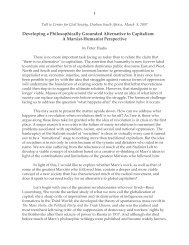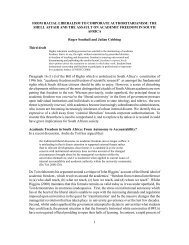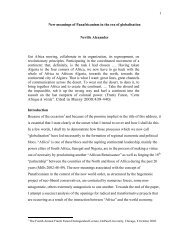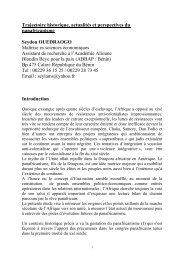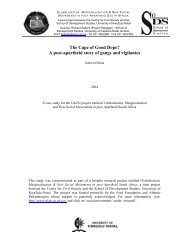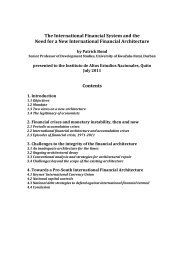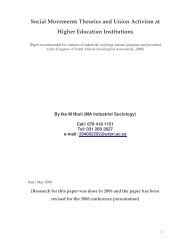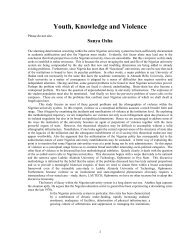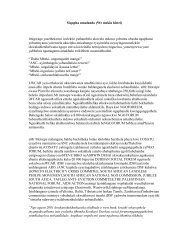April 2011 - Centre for Civil Society - University of KwaZulu-Natal
April 2011 - Centre for Civil Society - University of KwaZulu-Natal
April 2011 - Centre for Civil Society - University of KwaZulu-Natal
You also want an ePaper? Increase the reach of your titles
YUMPU automatically turns print PDFs into web optimized ePapers that Google loves.
and Peter Lukey, both from struggle-era backgrounds in land and<br />
environmental NGOs, and once dedicated to far-reaching social change.<br />
But people like this (yes, me too) are notoriously unreliable, and I was not<br />
at all surprised to hear last week that Yawitch is moving to the National<br />
Business Initiative, following the path through the state-capital revolving<br />
door so many be<strong>for</strong>e her also trod.<br />
At the Copenhagen COP in December 2009, lead G77 negotiator Lumumba<br />
Di-Aping accused Yawitch <strong>of</strong> having “actively sought to disrupt the unity <strong>of</strong><br />
the Africa bloc,” a charge she <strong>for</strong>ced him to publicly apologise <strong>for</strong>, even<br />
though within days Zuma proved it true by signing the Africa-frying<br />
Copenhagen Accord.<br />
Since the public comment period expires in ten days, let’s rapidly glance<br />
through the Green Paper. Right from the initial premise – “South Africa is<br />
both a contributor to, and potential victim <strong>of</strong>, global climate change given<br />
that it has an energy-intensive, fossil-fuel powered economy and is also<br />
highly vulnerable to the impacts <strong>of</strong> climate variability and change” – this<br />
document seems to fit within an all too predictable Pretoria <strong>for</strong>mula:<br />
talking left, so as to more rapidly walk right. (And having drafted more<br />
than a dozen such policy papers from 1994-2002, I should know.)<br />
This <strong>for</strong>mula means the Green Paper can claim, with a straight face:<br />
“South Africa, as a responsible global citizen, is committed to reducing its<br />
own greenhouse gas emissions in order to successfully facilitate the<br />
agreement and implementation <strong>of</strong> an effective and binding global<br />
agreement.”<br />
My suggestion <strong>for</strong> a reality-based rephrasing: “South Africa, as an<br />
irresponsible global citizen, is committed to rapidly increasing its own<br />
greenhouse gas emissions by building the third and fourth-largest coalfired<br />
power plants in the world (Kusile and Medupi) mainly <strong>for</strong> the benefit<br />
<strong>of</strong> BHP Billiton and Anglo American which get the world’s cheapest<br />
electricity thanks to apartheid-era, <strong>for</strong>ty-year discount deals, and to<br />
successfully facilitate the agreement and implementation <strong>of</strong> an ineffective<br />
and non-binding global agreement – the Copenhagen Accord – which is<br />
receiving support from other countries only because <strong>of</strong> coercion, bullying<br />
and bribery by the US State Department, as WikiLeaks has revealed.”<br />
Consistent with Washington’s irresponsible climate agenda, Pretoria’s<br />
Green Paper suggests we “limit the average global temperature increase to<br />
at least below 2°C above pre-industrial levels” yet this target is so weak<br />
that scientists predict nine out <strong>of</strong> ten African farmers will lose their ability<br />
to grow crops by the end <strong>of</strong> the century.<br />
In contrast, the 2010 Cochabamba People’s Agreement hosted by Bolivian<br />
president Evo Morales last <strong>April</strong> demanded no more than a 1-1.5°C rise, a<br />
vast difference when it comes to emissions cuts needed to reach back to<br />
350 parts per million <strong>of</strong> CO2 equivalents in our atmosphere, as ’science<br />
requires.’<br />
Failing that, the Green Paper acknowledges (using even conservative<br />
assumptions), “After 2050, warming is projected to reach around 3-4°C<br />
along the coast, and 6-7°C in the interior. With these kinds <strong>of</strong> temperature<br />
increases, life as we know it will change completely.” As one example,<br />
“the frequency <strong>of</strong> storm-flow events and dry spells is projected to increase<br />
over much <strong>of</strong> the country, especially in the east, over much <strong>of</strong> the Eastern<br />
Cape and <strong>KwaZulu</strong>-<strong>Natal</strong>, including some <strong>of</strong> the most crucial source regions<br />
<strong>of</strong> stream-flows in southern Africa such as the Lesotho highlands.”



